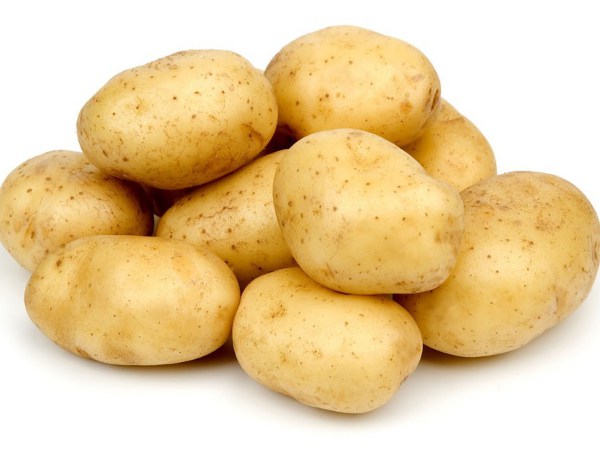
Russia is a country in whose territory more than 400 varieties of potatoes of foreign and domestic selection are cultivated. Potato Jelly is one of the most popular varieties.Deciding to plant such a vegetable crop as potatoes for their own needs or for the purpose of selling, novice gardeners and farmers ask themselves the question - which variety should be preferred. Potato Jelly is an example of a better choice. It is equally well suited for selling and experimenting in the kitchen. Another plus is high yield.
Content
Description and characteristics of Jelly potatoes
Potato Jelly in 2005 was included in the State register of selection achievements of the Russian Federation. The variety can be used for cultivation in industrial volumes, as well as on personal plots, farms. Tubers can be stored for up to several seasons without losing their germination ability.
The variety belongs to the middle early table setting. The interval between planting and harvesting is 3 months. In tubers, the starch concentration is about 17%.
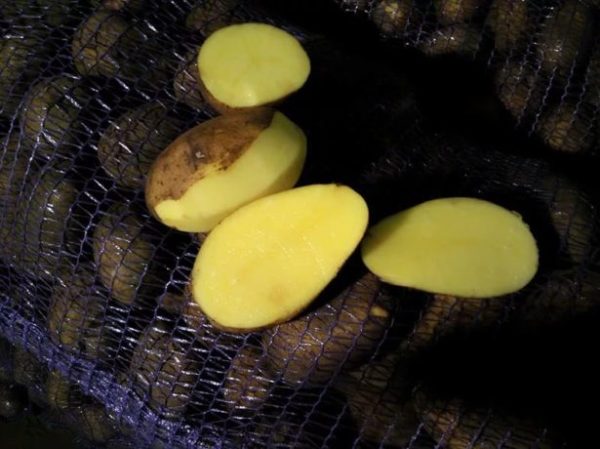
Giving characteristic to Jelly's potato, experts note that the bushes of the plant are semi-erect and sprawling. Leaves are medium or large, painted green.
Each tuber is small in size, has an oval shape. Weight ranges from 84 to 135 grams. As experienced breeders note, in one hole all tubers are the same size. Their surface is slightly rough, has a yellow tint. The pulp itself is dark yellow in color.
Potatoes due to the average content of starch can be used for both the first and second courses.
As reviews of potatoes of the Jelly variety show, its characteristic assumes yet another quality - resistance to weather fluctuations. It is not adversely affected by short-term heat and drought.
Productivity
As practice shows, the productivity of Jelly potatoes depends mainly on two factors - the composition of the soil (how nutritious it is) and climatic conditions.
Origin. Where is better to grow?
Potato Jelly is the result of the work of Holland breeders. In 2005, the variety was listed in the State Register of the Russian Federation.
The variety is optimal for cultivation in such areas:
- Central;
- Volga-Vyatka.
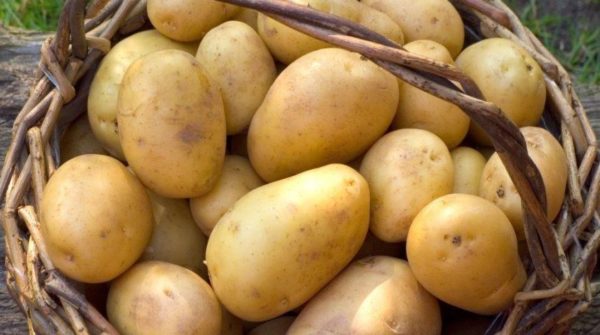
In general, as practice shows, any area with a warm and temperate climate is suitable for potatoes.
Advantages and disadvantages
Jelly potatoes have a number of advantages. Among them:
- high taste;
- large tubers are the same size and weight;
- large volumes of harvested crops;
- can be stored for long periods of time without loss of quality as a commodity;
- resistance to low rainfall;
- optimal for amateur and industrial cultivation;
- unpretentious care;
- resistance to most known potato diseases.
The relative disadvantage of Jelly potatoes is some limited choice of dishes in which this variety can be used.
Growing rules
The Jelly potato variety is best grown in light, fertile soils with a high sand content.Species characteristics allow changing landing sites. Alternation with radish, fatseliya, legumes is allowed.
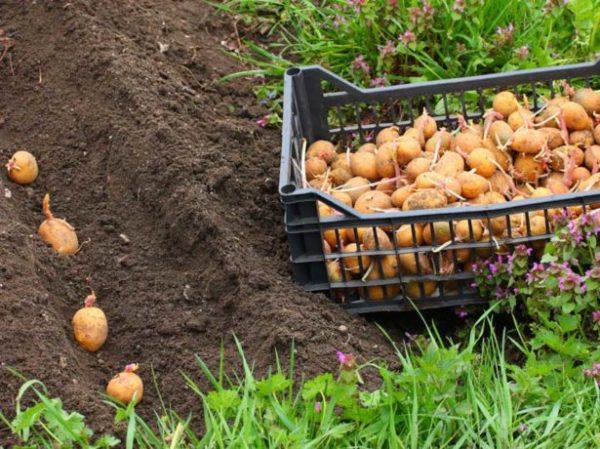
Before planting, the plot is cultivated. The remaining plants, tubers must be removed.
The soil
To get a high yield, they begin to prepare the soil for planting in the autumn period. For this, a mixture of 100 g of ash and 3 kg of manure is applied per square meter. After the fertilizer is scattered over the entire surface of the site, digging is done to the depth of the shovel. Nitrogen or urea is not recommended, since this substance lengthens the growing season, which, in turn, leads to a decrease in yield.
Seed preparation
The preparation of planting material begins three weeks before the start of the procedure. For this, the tubers are laid out on a flat surface in one layer. The room should be warm, humid and well lit. If weather conditions permit, potatoes selected for planting are laid out in open areas under direct sunlight.
By the time the tubers turn green, their eyes “wake up” and begin to sprout. Those tubers that have strong sprouts firmly held on the uterus have the greatest survival.
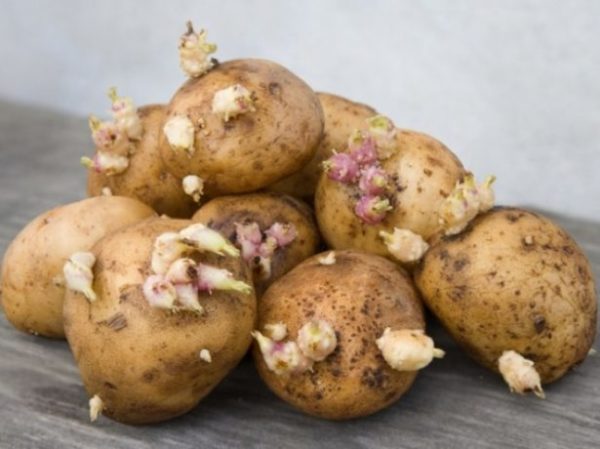
For storage, not only small, medium-sized tubers are selected, but also large ones. Only they should be cut into several parts before planting. As follows from the description of Jelly potatoes, this vegetable crop suffers a similar procedure without loss of quality.
Landing
To obtain a high crop, the sizes of which are regularly indicated in numerous reviews, the rules of agricultural technology should be strictly observed.
Between the rows leave a distance of 75 cm, and between the tubers - 35 cm (but not less). Compliance with this rule will eliminate the likelihood of developing crowded planting and, consequently, a decrease in yield. In addition, crowding excludes free penetration of light and heat. This, in turn, is the main reason for the development of diseases.
Care Rules
The description of Jelly potato shows that care does not take much effort. In particular, this species easily tolerates a dry period, therefore, frequent watering should not be resorted to.
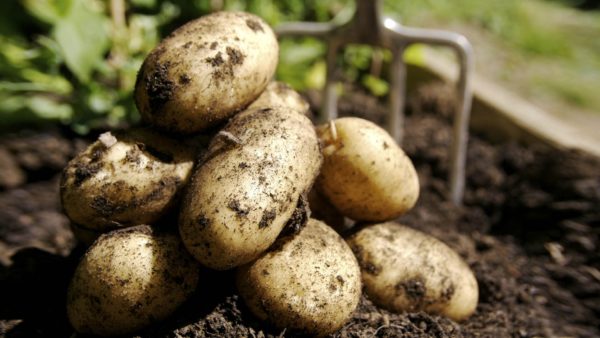
Diseases and Pests
As practice shows, Jelly potatoes are not susceptible to potato cancer, common scab, cyst nematode, black leg. Also, the species is not exposed to most known viruses. Regarding late blight, resistance to it is moderate. To reduce the likelihood of developing this disease, careful soil treatment is recommended before planting. After the harvest is fully harvested, all tubers, plant debris are removed so as not to create a breeding ground for pathogenic bacteria.
Important: if there is an epidemic of late blight, the site and plants are treated with specialized drugs. It should be remembered that processing is not carried out about 20-30 days before the harvest is carried out.
The bush part of the plant can be affected by the Colorado potato beetle. And tubers - with wireworms or larvae of the nutcracker. You can save landing if you treat them with insecticides in a timely manner. As a preventive measure, a change in landing sites should be considered. This will increase the immunity of plants, the stability of the tubers themselves.
Harvesting and storage
It is recommended to collect Jelly potatoes in dry and sunny weather. This will contribute to the good preservation of the tubers. Potatoes must be laid out on the ground for drying. After that, it is transferred under a canopy to avoid contact with water and left for seven days.
In order to increase preservation, potatoes are sorted before the final storage. Be sure to remove those that received even minor damage during digging.
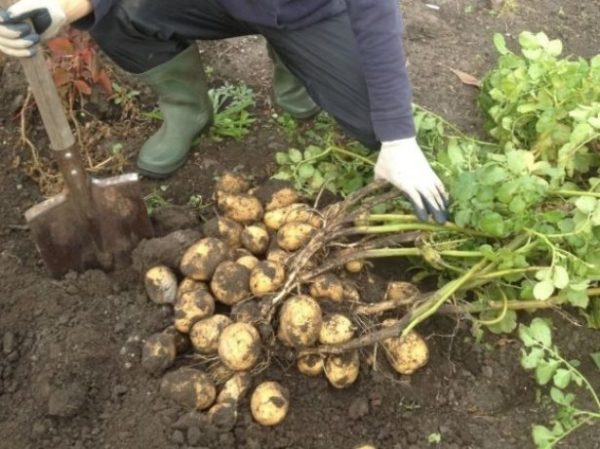
At home, a basement or any other room in which a constant temperature is maintained is suitable for storage, there is no moisture and there is no access to direct sunlight. It is recommended to organize ventilation. Farmers and larger farms use vegetable stores.
Reviews
Getting to know the Jelly potato variety and looking at the photo is hard to get a complete picture of the plant; feedback is of great help. Here are some of them.
Olga, 35 years old, Chita:
“The city in which I live is located in a risky farming zone. Therefore, it is extremely difficult to choose a variety that can yield a high yield in difficult climatic conditions. But I still decided to try and brought 20 tubers. Planted and, to my surprise, received a good harvest - one and a half buckets of yellow and even tubers. The whole family liked her taste. ”
Alexander, 35 years old, Nyazepetrovsk:
“A neighbor in the country shared potato tubers, a variety of which I did not know — Jelly. Praised. My wife and I decided to plant several beds and see what happens from our experiment. Honestly, we were very pleased with the result. They treated everything in a timely manner, prepared the soil correctly and no diseases on the potato. The potatoes themselves are delicious. ”
Nina, 55 years old, Moscow region:
“Boiled potatoes are my weakness. Once I bought potatoes with an interesting name on the market - Jelly. Planted. The harvest is certainly not very high (I have varieties at the dacha that give even more), but the taste is better than all others. ”




 Description and description of varieties in Belarus with a photo
Description and description of varieties in Belarus with a photo Do I need to pick flowers from potatoes: why do they do it
Do I need to pick flowers from potatoes: why do they do it When to dig potatoes: timing and availability of new potatoes
When to dig potatoes: timing and availability of new potatoes How to grow a good potato crop: various methods and methods, planting and care
How to grow a good potato crop: various methods and methods, planting and care